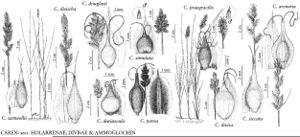Difference between revisions of "Carex douglasii"
in W. J. Hooker, Fl. Bor.-Amer. 2: 213, plate 214. 1839.
FNA>Volume Importer |
imported>Volume Importer |
||
| (6 intermediate revisions by 2 users not shown) | |||
| Line 1: | Line 1: | ||
{{Treatment/ID | {{Treatment/ID | ||
|accepted_name=Carex douglasii | |accepted_name=Carex douglasii | ||
| − | |accepted_authority=Boott | + | |accepted_authority=Boott |
|publications={{Treatment/Publication | |publications={{Treatment/Publication | ||
|title=in W. J. Hooker, Fl. Bor.-Amer. | |title=in W. J. Hooker, Fl. Bor.-Amer. | ||
|place=2: 213, plate 214. 1839 | |place=2: 213, plate 214. 1839 | ||
|year=1839 | |year=1839 | ||
| + | }} | ||
| + | |special_status={{Treatment/ID/Special_status | ||
| + | |code=F | ||
| + | |label=Illustrated | ||
}} | }} | ||
|basionyms= | |basionyms= | ||
| Line 23: | Line 27: | ||
|elevation=500–3500 m | |elevation=500–3500 m | ||
|distribution=Alta.;B.C.;Sask.;Ariz.;Calif.;Colo.;Idaho;Mo.;Mont.;Nebr.;Nev.;N.Mex.;N.Dak.;Oreg.;S.Dak.;Utah;Wash.;Wyo.;Mexico (Baja California). | |distribution=Alta.;B.C.;Sask.;Ariz.;Calif.;Colo.;Idaho;Mo.;Mont.;Nebr.;Nev.;N.Mex.;N.Dak.;Oreg.;S.Dak.;Utah;Wash.;Wyo.;Mexico (Baja California). | ||
| − | |discussion=<p>The stigmas of Carex douglasii are very long and form a tangled mat that persists essentially until the perigynia mature, giving a distinctive appearance to pistillate inflorescences of the species. Though the plants are uniform in appearance superficially, the perigynia are quite variable in shape and size.</p><!-- | + | |discussion=<p>The stigmas of <i>Carex douglasii</i> are very long and form a tangled mat that persists essentially until the perigynia mature, giving a distinctive appearance to pistillate inflorescences of the species. Though the plants are uniform in appearance superficially, the perigynia are quite variable in shape and size.</p><!-- |
--><p>The Missouri locality is an introduction in a railway yard.</p> | --><p>The Missouri locality is an introduction in a railway yard.</p> | ||
|tables= | |tables= | ||
| Line 33: | Line 37: | ||
-->{{#Taxon: | -->{{#Taxon: | ||
name=Carex douglasii | name=Carex douglasii | ||
| − | + | |authority=Boott | |
| − | |authority=Boott | ||
|rank=species | |rank=species | ||
|parent rank=section | |parent rank=section | ||
| Line 47: | Line 50: | ||
|publication title=in W. J. Hooker, Fl. Bor.-Amer. | |publication title=in W. J. Hooker, Fl. Bor.-Amer. | ||
|publication year=1839 | |publication year=1839 | ||
| − | |special status= | + | |special status=Illustrated |
| − | |source xml=https:// | + | |source xml=https://bitbucket.org/aafc-mbb/fna-data-curation/src/2e0870ddd59836b60bcf96646a41e87ea5a5943a/coarse_grained_fna_xml/V23/V23_528.xml |
|genus=Carex | |genus=Carex | ||
|section=Carex sect. Divisae | |section=Carex sect. Divisae | ||
Latest revision as of 20:41, 5 November 2020
Rhizomes 0.8–1.9 mm thick, shoots often arising 2–several per cluster, many nodes without shoots. Culms bluntly trigonous, (8–)15–40 cm, smooth-angled distally. Leaves: basal sheaths pale to dark brown; sheaths with hyaline inner band, apex not prolonged, glabrous; ligules 0–2.8 mm; blades 1–3(–3.5) mm wide. Inflorescences dense, headlike, 1.2–3.5(–4.5) cm, 1/2+ as wide as long (if pistillate); spikes 6–20(–25), usually unisexual; staminate spikes lanceoloid; pistillate spikes ovoid. Pistillate scales pale brown to ± whitish hyaline, hyaline margins, lanceolate to ovate, (4.3–)4.7–7.5 mm, apex acute to acuminate, satiny to ± dull. Anthers (2.5–)2.8–3.9 mm, apiculus bristly (30X). Perigynia brown, essentially veinless, usually stipitate, ovate to broadly elliptic, ± plano-convex, (3–)3.5–4.2(–4.8) × 1.2–2.1 mm, dull; beak (0.9–)1.2–1.9 mm, apex hyaline, friable, oblique or obscurely bidentulate.
Phenology: Fruiting Jun–Aug.
Habitat: Prairie, sagebrush grasslands, forest openings, meadows, marsh edges, stream banks, in dry to wet soils, various open, successional and usually moist habitats, tolerant of alkaline soils
Elevation: 500–3500 m
Distribution

Alta., B.C., Sask., Ariz., Calif., Colo., Idaho, Mo., Mont., Nebr., Nev., N.Mex., N.Dak., Oreg., S.Dak., Utah, Wash., Wyo., Mexico (Baja California).
Discussion
The stigmas of Carex douglasii are very long and form a tangled mat that persists essentially until the perigynia mature, giving a distinctive appearance to pistillate inflorescences of the species. Though the plants are uniform in appearance superficially, the perigynia are quite variable in shape and size.
The Missouri locality is an introduction in a railway yard.
Selected References
None.
